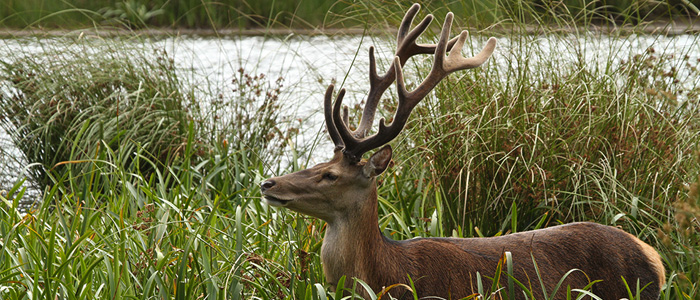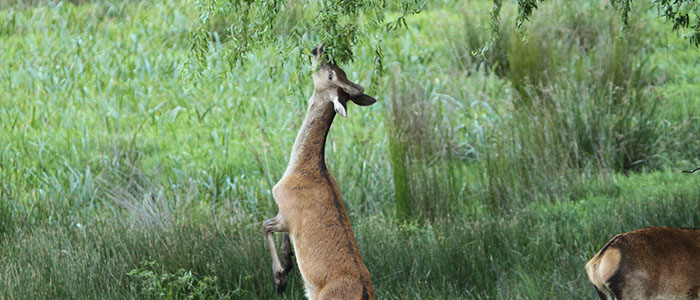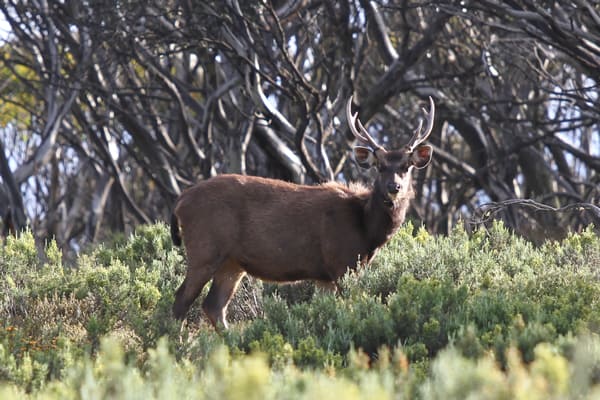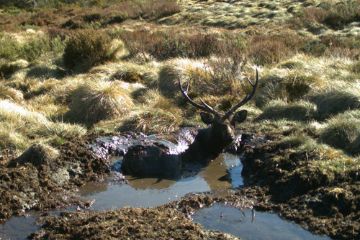
Environmental damage is increasing as a result of Victoria’s rapidly expanding feral deer population.
Victorian farmers and wildlife are in for tough times – feral deer populations are flourishing and spreading.
It is the legacy of acclimatisation, which was enthusiastically supported in the 1800s by the likes of Victoria’s governor and the editor of the state’s major newspaper, and which saw attempts to introduce exotic monkeys, birds, giraffes, other creatures – and deer – into the state. Thankfully, this fad has largely faded but the deer remain.
The political power of the hunting lobby has ensured that the rising population of feral deer remains unmonitored, unchecked and officially unimportant. In the absence of monitoring, there are two trends that justify alarm.
There are increasing reports of deer affecting farmers (deer graze and browse crops, fruit trees and grassy paddocks meant for livestock, and destroy fences), causing car accidents, and impacting on important patches of bushland such as in the Dandenong Ranges.
Secondly, regular reports of the number of deer killed by hunters show that it has become much easier to kill them. For the most common deer in Victoria, sambar, their numbers killed by hunters have rocketed from 8500 in 2004 to 47,000 in 2014. In a decade the number of sambar deer killed annually has increased almost five-fold, while the number of hunters has increased only four-fold. These numbers suggest a population of at least several hundred thousand, perhaps more.
The Victorian Government admits that hunting is failing to control deer, saying it ‘appears to have little noticeable effect on the success of the species’, that sambar have steadily extended their range into NSW and the ACT, and that their density is increasing. The numbers of fallow and red deer shot have also risen and exceed the rise in hunter numbers.
Sambar deer are already officially recognised as impacting on threatened plants with a listing as a ‘potentially threatening process’ under Victoria’s threatened species legislation. All deer are heavy grazers or browsers, reducing plant diversity and competing with other native animals. They cause physical damage through trampling, erosion and wallowing, and spread weeds and diseases. Deer create extensive tracks through moist gullies, removing ground cover and assisting the movement of other feral animals.
Fears of a backlash
The Victorian Government has felt unable to act for fear of a hunting community backlash. But feral deer are not an either/or problem. Unfortunately, it is impossible to eradicate them so recreational hunters will always have deer to kill. By pandering mainly to hunters with a narrow policy agenda, the government is neglecting the environmental, economic and social costs of the growing feral deer population.
Treating deer as the problem pest they really are requires better laws and policies. The key role lies with the Victorian Government, only it can deal with an emerging pest requires a coordinated response.
There first needs to be public acceptance of the problem, facilitated by declaring feral deer a pest species and removing the out-of-date protected game species status under the Wildlife Act 1975. Understanding of the problem would be assisted by a systematic assessment of deer populations across Victoria.
A feral deer management strategy is also needed and should include a funded and systematic approach to preventing the spread of feral deer and reducing their impacts. Priority would be given to eradicating small isolated populations and lowering impacts on high conservation areas, minimising traffic accidents and limiting other damage. Greater controls are needed to prevent deer escaping from farms and the deliberate movement of deer by hunters, and there needs to be research on new control measures, including humane baits.
Recreational hunting will continue to be supported by government but it must not be mistaken for feral animal control. It is ad-hoc, dispersed and opportunistic, conducted by hunters with variable skill levels and often targeting trophy males. Restrictions such as bans on night hunting and the use of spotlights also limit its effectiveness.
Skilled volunteer shooters can still be helpful if engaged under supervision to help with coordinated, strategic and supervised control efforts, as has recently begun in the Dandenong Ranges and Yellingbo areas, and used successfully for feral goats in the Little Desert National Park for some years.
Allowing widespread unsupervised hunting in national parks is not the answer, although it appears to be the real agenda of the hunting lobby – acclimatisation in another guise.

Ridding the Grampians of deer
Steve Morvell, wildlife artist, former park ranger and long-term Halls Gap resident, recently wrote to environment minister, Lisa Neville, about the deer problem facing the Grampians National Park:
‘I am deeply concerned about … the proliferation of feral deer in our beautiful park. … Where 20-years back seeing one or two was unusual, herds of 25 are now not uncommon here in the Halls Gap valley. I myself have counted 56 individuals browsing peacefully within 600 metres of the Parks Vic offices and have on many occasions observed them grazing right outside the office windows there. Hardly a good advertisement for park management.’
In their reply to Steve’s concerns Parks Victoria confirms that deer control is not a priority and says remote cameras have detected fallow deer in the core of the Grampians National Park first the first time.
The Grampians is a perfect place to run a deer eradication program. While millions will be spent on a new tourist-friendly walking track through the Grampians National Park, the areas the visitors walk through are increasingly being damaged by red and fallow deer.
This article was first published in the June 2015 edition of Park Watch, the quarterly publication of the Victorian National Parks Association.
More info




